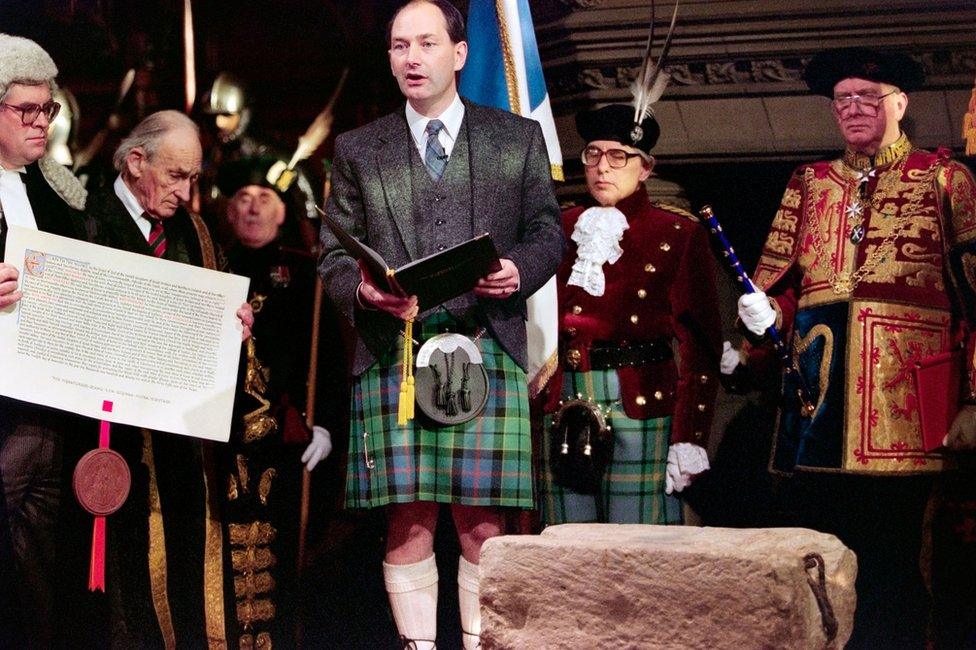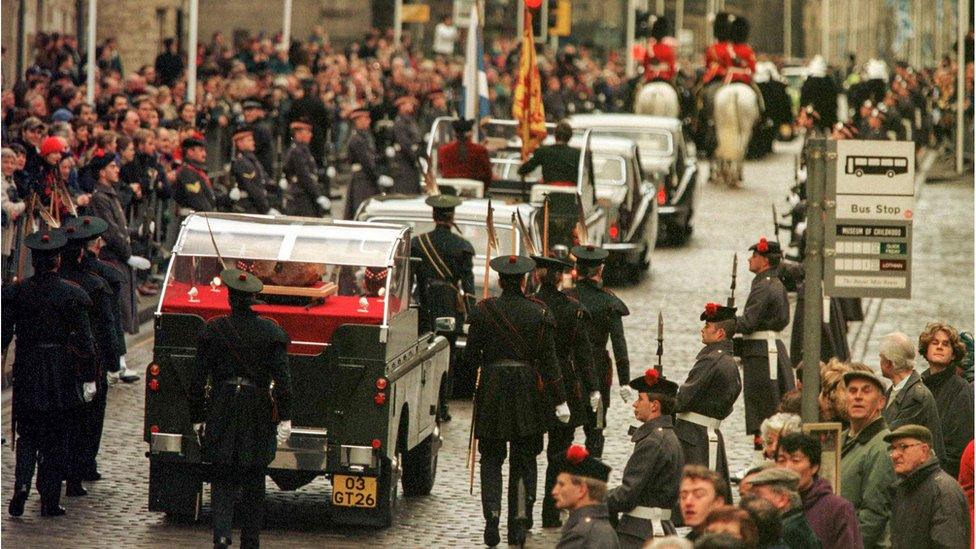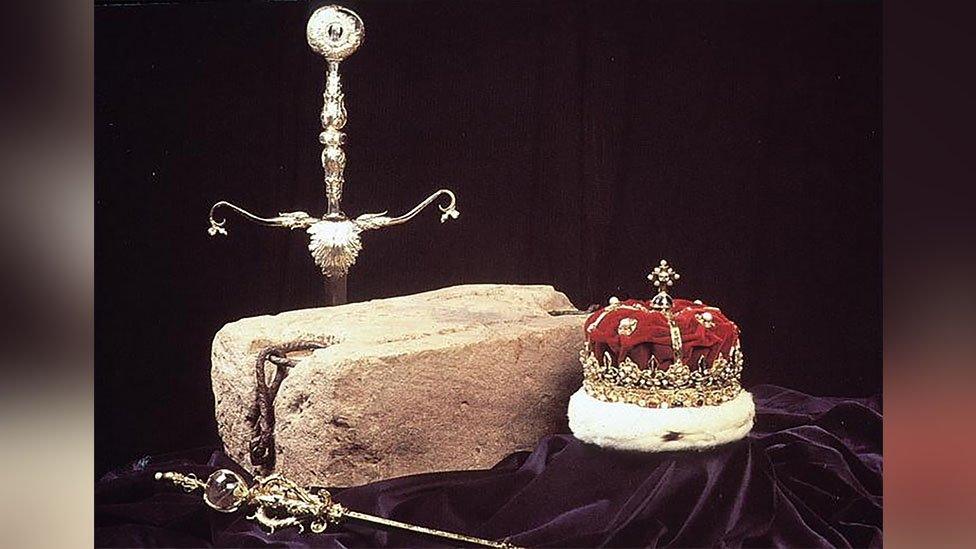The day the Stone of Destiny returned to Scotland
- Published

Members of the Royal Archers escort an Army Land Rover carrying the Stone of Destiny across Edinburgh Castle esplanade
On St Andrew's Day 1996, Scotland had a date with destiny as a symbolic centuries-old stone returned home.
Ever since I followed its journey up the Royal Mile in Edinburgh as a newspaper reporter 25 years ago, I have been intrigued by this great big lump of red sandstone.
The Stone of Destiny is thought to be the coronation seat for Scottish Kings but it was stolen from Scone, the capital of the ancient Pictish kingdom, by Edward I of England in 1296.
He placed it beneath the Coronation Chair of Westminster Abbey in London and it has been used in every coronation there since then.
In the early hours of Christmas day 1950 it was unofficially brought home to Scotland by four Glasgow University students.
Ian Hamilton, Kay Matheson, Gavin Vernon and Alan Stuart managed to get the stone out of the abbey, into a car and headed north despite numerous roadblocks and searches.
The police never managed to find it and eventually the stone reappeared at Arbroath Abbey in April 1951 covered in a Saltire.
It was then returned to London and stayed there until that surreal day at the end of November 1996 when I caught my first glimpse of the legendary stone as it was driven up the Royal Mile in the back of a Land Rover.

Scottish Secretary Michael Forsyth with the stone at a ceremony in the Great Hall of Edinburgh Castle
Michael Forsyth, the Scottish Secretary at the time, was the man responsible for its return.
The former Conservative minister, who is now Lord Forsyth of Drumlean, told me the decision to bring the stone home was a "no brainer".
He said some people thought it was a political stunt.
But he said was not stupid and he knew it would not turn the political tide in favour of the Conservatives, who would go on to lose all their Scottish seats the following May.
"It wasn't a political stunt. It was the right thing to do," Lord Forsyth said.
The day of the return was nerve-racking for Richard Welander and a team from Historic Scotland.
They travelled by train overnight and then were driven at top speed through the streets of London with an armed police escort.
"It was all very cloak and dagger," Mr Welander said.

The Stone of Destiny is transported up the Royal Mile in Edinburgh, on its way to Edinburgh Castle after being kept at Westminster
They were about to do something which had never been done before - officially.
"It became very clear to me that this was going to be a quite a challenge," he said.
The operation to remove the stone took from 8pm until 2am.
They had to painstakingly catalogue everything so they would know how to put the stone back together again in position for when it is needed for the next coronation.
"It's a stone that's still on duty," Mr Welander told me 25 years after he helped move it.
As the removal was going ahead in Westminster Abbey, news that the stone was on the move again was filtering out.
William Murray, now Viscount Stormont, was just eight years old in 1996 when he heard the stone was coming home but not to his home at Scone Palace.
He remembers all the pageantry but was disappointed it was not travelling to Scone.
But now the stone is about to be moved again. This time it is going from Edinburgh Castle to Perth.
The decision to move it to Perth was announced last year by First Minister Nicola Sturgeon.
She is one of the four commissioners for the safeguarding of the regalia who advised the Queen about all matters relating to the stone.
Viscount Stormont admits to feeling mixed emotions about the Stone of Destiny coming that bit closer when it moves to Perth in 2024.
"Obviously we would love for it to be at Scone," he said. "But it's going to be a couple of miles away. It's basically home so that's good enough."
For Fiona Robertson, moving the stone to Perth will be "a game changer".
She is the head of culture at Perth and Kinross Council and, complete with hard-hat and high viz jacket, she picked her way carefully through all the construction work going on at Perth City Hall to show me how it is being prepared for the arrival of the stone.

The Stone of Destiny and Honours of Scotland are currently at Edinburgh Castle
"We are bringing it back here to Perth to show it in its true historical context," she said.
But does it matter?
"The stone is a really important re-connection with why Perth matters in Scotland's history and UK history," she said.
"It's really emerging as one of the most exciting tourist destinations in the east of Scotland and elsewhere.
"So the stone and the wider exhibitions are important and of course it will be free to see."
And so from 2024, the stone's new home will be in Perth until it is needed back in Westminster Abbey for the next coronation and that opens up a whole range of possible stories for the future.
- Published23 December 2020
